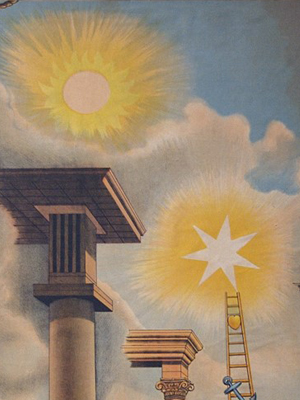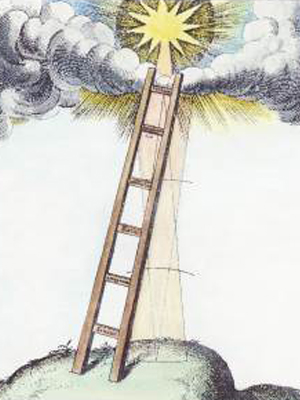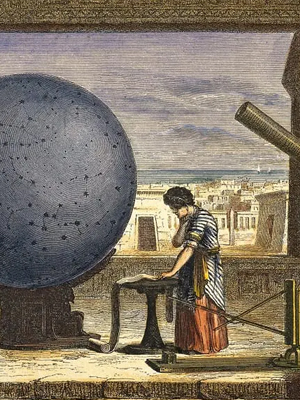
Masonic Articles and Essays
Stars in Freemasonry: Why should we always look up?
Very Ills... Bro. Pamela McDown 33o
Date Published: 9/8/2023
Freemasonry directs its Initiates to always look upwards, not only to those lofty ideals which it inculcates, but to the stars themselves. Man has followed the course of the stars from time immemorial but whither are they directing his course? What glorious future awaits us at the end of our long voyage?
 “Remember to look up at the stars and not down at your feet. Try to make sense of what you see and wonder about what makes the universe exist. Be curious.” – Steven Hawking
“Remember to look up at the stars and not down at your feet. Try to make sense of what you see and wonder about what makes the universe exist. Be curious.” – Steven Hawking
For countless generations, humanity has gazed upon the heavenly abyss with awe. Looking up at the night sky gives us a glimpse of the Universe beyond our terrestrial concerns. In Freemasonry, some of the most sublime moments in our rituals occur when we are asked to look up. The whole Lodge space is symbolically placed under a celestial canopy. Why? Perhaps one reason is that when we look up, we are led to the handiwork of the Great Architect. We realize how a far-away star can somehow connect us to the One who made it. Let us explore, then, the relationship between Freemasonry and Stars.
The Philosophy of Stars
“Know that the philosopher has power over the stars, and not the stars over him.”
? Paracelsus
In ancient times, philosophers approached the relationship between stars and humans from different perspectives, but all recognized a certain connection or influence between the celestial and terrestrial realms.
1. Plato, the ancient Greek philosopher, believed in a cosmic harmony and the celestial bodies exerted an influence on earthly affairs, shaping human destinies and reflecting the order and beauty of the cosmos.
2. Plotinus, a philosopher of the 3rd century CE, viewed the stars as emanations from the One, the ultimate divine source. He believed that the stars, as celestial beings, possessed a higher level of being and intelligence than humans. However, he also emphasized that the human soul had the potential to transcend its earthly limitations and reunite with the divine through contemplation and philosophical ascent.
3. Hermes Trismegistus taught that the stars were infused with divine energies and intelligence, and they transmitted spiritual knowledge and influences to humanity. The stars were seen as intermediaries between the divine and the earthly realms.
Of course, these early thinkers did make a few mistakes. For instance, Ptolemy, an astronomer during the 2nd century BC, ended his world in the middle of China because his perception of the Mediterranean was off by about 30%. All in all, he was forgiven for his mistakes because his observations of the celestial heavens were remarkedly recorded only with the naked eye.
What Masonic symbols might correlate with some of these ancient philosophical ideas?
The Blazing Star in the Masonic Lodge
Those who have had the good fortune to have actually seen the inside of a Masonic Lodge will know with what prominence the Blazing Star is displayed. It presents itself soon after a brother first enters the lodge and begins participating in rituals and degree work. On the John Harris 1st Degree Tracing Board in the Masonic Lodge, it is illustrated as a seven-pointed star with the sun and moon and stars displayed around it. While each of the luminaries have significant meanings, the Blazing Star outshines them all, as the apex of a brother’s journey up Jacob’s Ladder. The sun and moon and stars are the "lesser lights," or subordinate luminaries, through which the supernal Light of the Blazing Star is mediated.
 It is taught that the Blazing Star is a symbol of Deity, of Omnipresence (the Creator is present everywhere), Omniscience (the Creator sees and knows all) and Omnipotence (the Creator is all powerful). Masonic Scholar Brother Albert Mackey wrote that the Blazing Star appears differently in several of the Scottish Rite Degrees, symbolizing the guiding light of the Divine, which points the way of Veritas or truth. For example, in the Third Degree it is first seen as a "glimmering ray" but then breaks forth in full splendor as "that Bright Morning Star whose rising brings peace and salvation to the faithful and obedient.” The lesson is that as the Freemason perfects himself by pursuing truth, he becomes like a Blazing Star, shining brightly in the midst of darkness. Along his journey, he always receives the guidance of a star, before becoming a light in the world himself. The quest for "that which is lost" is not only a journey outward, to seek Divinity beyond the horizon, it is a journey inward, to let Light illumine the heart.
It is taught that the Blazing Star is a symbol of Deity, of Omnipresence (the Creator is present everywhere), Omniscience (the Creator sees and knows all) and Omnipotence (the Creator is all powerful). Masonic Scholar Brother Albert Mackey wrote that the Blazing Star appears differently in several of the Scottish Rite Degrees, symbolizing the guiding light of the Divine, which points the way of Veritas or truth. For example, in the Third Degree it is first seen as a "glimmering ray" but then breaks forth in full splendor as "that Bright Morning Star whose rising brings peace and salvation to the faithful and obedient.” The lesson is that as the Freemason perfects himself by pursuing truth, he becomes like a Blazing Star, shining brightly in the midst of darkness. Along his journey, he always receives the guidance of a star, before becoming a light in the world himself. The quest for "that which is lost" is not only a journey outward, to seek Divinity beyond the horizon, it is a journey inward, to let Light illumine the heart.
One of the most intriguing theories of the Blazing Star is found in Brother Albert Pike’s Morals and Dogma where he writes: "Sirius still glitters in our Lodges as the Blazing Star."
The Star Sirius and Anubis
The Blazing Star is one of the three key ornaments in a Masonic Lodge, along with the Mosaic Pavement and Indented Border. According to Brother Pike it originally identified with not only Sirius, but the Egyptian jackal- headed god Anubis, guardian, and guide of souls. He said, "The Blazing Star in our Lodges represents Sirius, Anubis, or Mercury, Guardian and Guide of Souls."
Anubis was the Egyptian God of the underworld who was the guide of the deceased in the afterlife state. He has the head of a jackal, with pointed ears and snout, with strong indication that he is actually a dog. He was charged with assisting Horus with tending the scales upon which were weighed the hearts of the dead, making sure that the weighing was fair. In this symbolism, the scales are suggested to be the scales of karma.
Figures such as Anubis, Thoth, Hermes, and Mercury all stand for and symbolize superior knowledge and the tools that Humanity will need to build its Spiritual Temple. It was thought that proper use of these tools, making further progress in the arts and sciences, would lift mankind closer to the status of the Gods.
In the simplest of terms, it can be said that the Egyptians linked the nature of Sirius and Anubis with key esoteric doctrines:
1. The reality of the Soul and its recurrent incarnations
2. The centrality of karma as a determining factor in the life of the inner man, and
3. The relevance of celestial influence to the evolution of human consciousness.
Brother Pike professes that all the mystery teachings and traditions of classical antiquity show telling signs of origin in the Egyptian initiatory tradition and Sirius. In fact, Brother H.P. Blavatsky, in her Secret Doctrine calls Sirius "the great instructor of mankind." If Sirius is indeed the Blazing Star in our Lodges, such a genesis would endow the inner spiritual kernel of Freemasonry with the mark of sanctification.
 In closing, exploring stars and the Lodge’s celestial canopy adds further insight into where a Freemason comes from and where he is going. It seems to reveal a message that there exists a perennial philosophy, moving through a vast lineage of initiates. These teachings ever bear witness to the presence of a wisdom tradition holding firm at the core of evolution on this planet. Although we may not be able to ever know through our human minds where Freemasonry’s true celestial home is, it is worth searching for. And on the journey, we must remember to look up!
In closing, exploring stars and the Lodge’s celestial canopy adds further insight into where a Freemason comes from and where he is going. It seems to reveal a message that there exists a perennial philosophy, moving through a vast lineage of initiates. These teachings ever bear witness to the presence of a wisdom tradition holding firm at the core of evolution on this planet. Although we may not be able to ever know through our human minds where Freemasonry’s true celestial home is, it is worth searching for. And on the journey, we must remember to look up!
